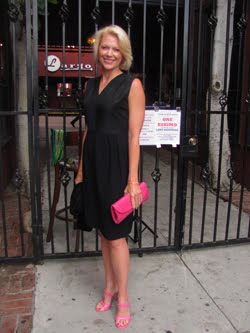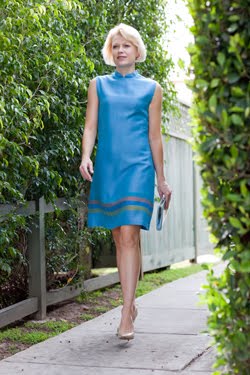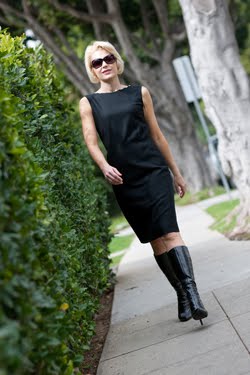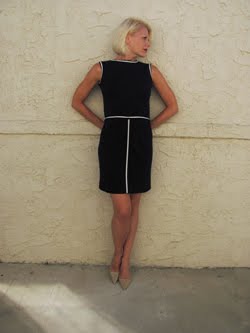As most know, I am an enormous fan of film noir, particularly those that premiered in the 1940s, and have written about many of them on GlamAmor. It seems appropriate, then, that I have been asked to speak on this very subject at the Skirball Cultural Center on December 7th as part of their extensive Light & Noir exhibition. In discussing The History of Fashion in Film Noir, I will go beyond the genre itself to reveal how impactful these films and their style were at the time. I will also show how this same style has become iconic and continues to inspire design today. One of the films that will be featured in the presentation is 1942's This Gun for Hire.
This Gun for Hire has two talents who both have birthdays around this time of year--star Veronica Lake (November 14) and costume designer Edith Head (October 28)--which makes for a perfect moment to celebrate this film. Edith Head is perhaps the best known costume designer of all time. During her six decade long career, she won 8 Oscars and was nominated 35 times; no other costume designer even comes close. She started at Paramount in 1923 assisting head costume designer Howard Greer and Travis Banton. After 15 years of studying and supporting the masters, she became the next to lead the department and would do so until 1967 when she went to Universal. As Paramount's head costume designer, she was prolific. She is probably best known for her work with director Alfred Hitchcock and creating the iconic style of the Hitchcock Heroine--such as Grace Kelly in Rear Window (1954) and To Catch a Thief (1955), Kim Novak in Vertigo (1958), and Tippi Hedren in The Birds (1963) and Marnie (1964). Beyond that, she won 2 of her Oscars for even more iconic work--Bette Davis in All About Eve (1950) and Elizabeth Taylor in A Place in the Sun (1951), which were particularly meaningful as both actresses were also friends.
While most remember Edith for these movies, far too many people forget how instrumental she was in establishing the style of film noir. After all, she worked on some of the most iconic film noir of them all. She designed for close friend Barbara Stanwyck in Double Indemnity (1944) as well as her idol Gloria Swanson in Sunset Boulevard (1950). Edith's tenure with Hitchcock even began with film noir--Ingrid Bergman in 1946's Notorious. And another star from film noir who Edith worked with throughout her career happens to still be revered for her style by those in fashion--Veronica Lake. This Gun for Hire was their first film noir together.
Many things came together on This Gun for Hire to make it a hit. First, it was based on a novel by Graham Greene. He, of course, is responsible for other novels that were adapted for the screen--The Quiet American, The End of the Affair, and film noir The Third Man. Secondly, its cinematographer was the great John Seitz who, along with Edith, also helped establish much of the look of film noir. He is celebrated for his lighting on classics like Double Indemnity and Sunset Boulevard. Finally, This Gun for Hire was directed by Frank Tuttle, who started his career in the 1920s directing icons like Clara Bow and Gloria Swanson. He was also an early film noir pioneer for directing the original movie version of Dashiell Hammett's The Glass Key (1935). All that said, This Gun for Hire is really best known for it being the first time Veronica Lake and Alan Ladd were teamed together. This was the film where they started steaming things up as one of the great onscreen couples of all time.
However, like 1933's Flying Down to Rio with Ginger Rogers and Fred Astaire, This Gun for Hire was not a planned pairing for Lake and Ladd. Ladd was not even the lead--that part was played by Robert Preston. It's so early in his career that the credits conclude by "introducing Alan Ladd." This was done because his star was on the rise and his part of Raven is absolutely central to the film. The movie even opens with him, and within 5 minutes we know all there is to know about his character. Raven is a professional killer who, though quite cold and methodical in his work, shows he also has a deeply compassionate side. It's all about Ladd for 13 minutes until leading lady Lake (playing nightclub entertainer Ellen Graham) makes her own entrance. What an entrance it is...singing and doing magic tricks in her now famous longsleeve gold lamé evening gown.
Though Ellen has a boyfriend, and he's a detective with the L.A.P.D., it's her time with Raven that we remember. Ladd is legendary for his own impact on men's style--TCM host Robert Osborne told me Ladd has always been his great inspiration--for wearing both tailored suits and the staple trenchcoat beautifully. He has natural chemistry with Lake, which is only made better by their similar acting styles and dry delivery. They are complimentary in another important way as well--their height. Alan was reportedly anywhere between 5'5'' and 5'9" (most seem to settle on 5'6") and of course Veronica was only 4'11". Edith Head, who was only 5'1" and worked with other petite stars like Gloria Swanson, still said that Veronica "was possibly the smallest normal adult [she] had ever seen."
Paramount stars (in Edith Head designs)
Paulette Godard (5'4"), Dorothy Lamour (5'5"), and Veronica Lake (4'11")
As you can see in the photo above, Veronica was tiny. Edith found this to be a challenge like no other. "Her figure problems seemed insurmountable," she remembers thinking upon meeting the future star. Her height had to be addressed in the design. Fortunately, Edith found an certain asset to work with. "She had big breasts," Edith said, "which made her seem like a larger woman [onscreen]." Veronica's opening look in This Gun for Hire--the gold lamé gown she wears to sing "Now You See It"--is a perfect illustration of Edith's approach. It would quickly become Veronica's signature style and featured in all the film fan magazines like Modern Screen and Photoplay. There are several important elements of the design--long sleeves, body-conscious silhouette, fitted at the waist, and floor-length. Her bosom is highlighted with an open v-neckline, which also helps to elongate her. Then Edith added ruching to further enhance her breasts without revealing too much. These design elements would be used time and time again for Veronica, whether repeated in full-length gowns or day dresses, starting in Sullivan's Travels (1941) and then throughout her career at Paramount.
Other wardrobe choices in This Gun for Hire also accomplish the task of making the star seem taller, from their color to the accessories. Edith knew that using as few colors as possible would help give Veronica height onscreen and often made her outfits monochromatic. One example is the all-black fishing ensemble she wears while singing "I've Got You." The outfit seems slightly risqué yet carefully honors the restrictive Hays Code. Its sex appeal stems from shiny thigh-high black vinyl boots and a matching hat. Veronica's accessories in her outfits often added height, such as her platform heels and other hats that were a part of her signature style. Veronica's hats differed from many of her contemporaries; consider the broad-brimmed hats for Bette Davis in Now, Voyager (1942) and Ingrid Bergman in Casablanca (1942) that same year. In contrast, Veronica's hats were designed with more vertical than horizontal detail.
As wonderful as Edith's wardrobe was for her, it was really Veronica's hair that became the hugest hit. In fact, the studios experienced resistance from the public if they varied her hair too much. Over the years, I have heard several stories surrounding the origins of her iconic style. One is that her hair simply had a natural wave and tendency to fall over one eye. Her legendary makeup artist Wally Westmore may have noticed it first. Another story is that the wave came as the result of clipping her hair to the side during one particularly bad hair day. And yet another story is that she played "peek-a-boo" with the camera when a stray lock of hair fell over her eye during a photo shoot...hence how the style became known as the "peek-a-boo." It actually seems quite reasonable that all of the above is true.
The 1930s had been dominated by shorter hair styles, but the 1940s were different with the advent of World War II. Suddenly, girls no longer had time or money to spend at the salon, so their hair naturally grew longer. Veronica gave them a star with a look to emulate, and made the "peek-a-boo" an extremely popular style throughout the decade. You can see other film noir stars like Rita Hayworth and Ava Gardner somewhat follow suit, but no one had hair as long as Veronica's. Everyone loved her look--she became one of the pin-up girls for men fighting overseas and a style inspiration for women on the home front. Her hair was so famous that the government actually approached her to change it for the war effort. Many women worked in factories where it was dangerous to have long hair. And so change she did, and then eventually even cut it. Many say that cutting her hair was partly to blame for cutting short her career as well. Everyone loved her hair. They still do. There are plenty of people today who have never seen a Veronica Lake movie, but they still know her name because of her hair.
Veronica in LIFE magazine 1943
Veronica then advocated Victory Rolls as a more practical style for long hair during WWII
and then even cut it to support the war effort, which was considered a mistake by many
Veronica at her "peek-a-boo" peak in 1942's This Gun for Hire (below)
The 1940s were Veronica's moment. She was Paramount's biggest star. Her look, her attitude, and her roles, especially in film noir, dominated much of the decade. What's fascinating, though, is that her sultry screen persona was in direct contrast to her real one. Introverted and shy, and reportedly battling mental illness, she felt distinctly different from her characters and image. Like Rita Hayworth, Veronica found it was impossible to live up to expectations, either from the public or herself. She felt such a disconnect that during her frequent fittings of slinky gowns, Veronica used to tell Edith, "Pardon me while I put on my other head." Unfortunately, these struggles seemed to translate into being difficult on set. Co-star Frederick March, for example, is said to have renamed their film together "I Married a Bitch" and refused another saying, "Life's too short for two films with Veronica Lake." Tragically, by 1949, her career was largely over.
But in 1942, she was riding high. This Gun for Hire was a hit with audiences and the studio. It was such a success that Paramount immediately recast their remake of The Glass Key (1942), replacing Patricia Morison with Veronica so she could again co-star with Alan Ladd. Then their third film together--The Blue Dahlia (1946)--followed four years later and became yet another example of the finest in film noir. In This Gun for Hire, you can definitely feel the magic and see why she cast such a spell over America at the time. It continues to this day with a look that is absolutely iconic. Here is her first time with Alan Ladd and the film where it all seemed to come together.
Veronica Lake and Alan Ladd--
iconic style and one of the great screen couples of all time starting with This Gun for Hire
The opening gown for the film captures many of the elements that would become her signature style--
long sleeves, v-neck, ruched bodice, fitted waist, and floor-length (with platform heels, of course)
Edith accessorizes the gown with a brooch, bracelet, and rings
With her dress to meet the senator, Edith includes a statement necklace to simulate a more open neckline
and adds hat, gloves, and long fur stole all elongate the actress onscreen
Detective Lieutenant Michael Crane (Robert Preston)
gets a passionate kiss from girlfriend Ellen before she leaves San Francisco for L.A.
Raven (Alan Ladd) and Ellen meet for the first time on the train
where they sit together and he tries (unsuccessfully) to lift "5 bucks" from her
On the run with Raven--
her traveling suit is paired with peeptoe pumps and another hat that adds to her height
Her outfit to perform "I Got You" is beyond sexy
with its thigh-high vinyl boots
The shine from a black vinyl hat and black satin shirt
add to the monochromatic nature of the outfit, which also makes her seem taller
This keyhole dress features many of the same techniques to make Veronica seem taller--
her hat, the long sleeves, open neckline, and fitted waist
The chemistry between co-stars Ladd and Lake
is captured perfectly in this scene where he saves her
Sources
Head, Edith and Paddy Calistro. Edith Head's Hollywood. Santa Monica: Angel City Press, 2008.
Jorgensen, Jay. Edith Head: The Fifty Year Career of Hollywood's Greatest Costume Designer. Philadelphia: Running Press, 2010.
Images
DoctorMacro.com
ChicVintageBrides.com
PlasticLittleThings.com
All screen caps from Kimberly Truhler for GlamAmor























































































































3 comments:
Wow! I can't believe how teeny she looks in that photo with Dorothy Lamour and Paulette Goddard! I've read before that she was only 4'11", but it's surprising to see her standing next to those two other women. As you explained, that Edith Head sure knew what she was doing with Veronica's wardrobe. Veronica really does look so much taller in the film.
On another note, Veronica was a beautiful woman and very talented. It's so sad to think of her real-life struggles...
I knew you would love that photo, Ruth! That pic blew me away, too. Just incredible. I was always impressed by Edith Head, but as you say she REALLY made Veronica look so much taller in film.
I feel for her, too, and all her struggles. For a star like her to be largely forgotten while she was still alive and to have lived as she did is just so sad. If she only knew how much she is beloved today.
I'm a Veronica Lake enthusiast and am working on a re-biography of her. I call it a re-biography of her because her autobiography omitted so much and her "biography" by Jeff Lenburg was ATROCIOUSLY inaccurate and poorly written. Suffice it to say, thank you for keeping her memory alive and writing circumspectly about her. I'm still trying to track down Elaine, her oldest daughter, but it's been REALLY hard. She'd be in her mid -seventies now. Any info about her that you could share i'd greatly appreciate. You can email me at bmbrian@ucla.edu. Thanks a million!
Post a Comment